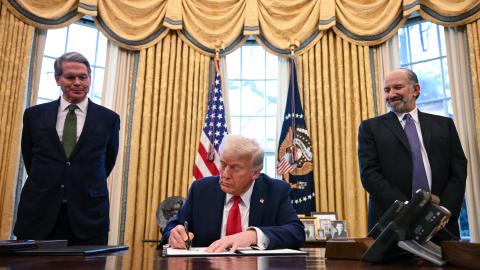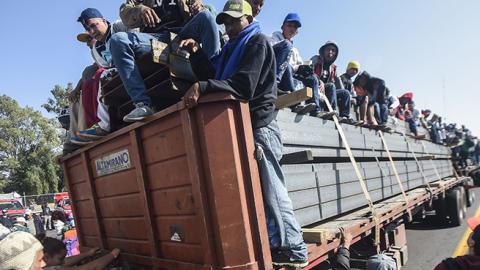Before the advent of political polarization radicalized by the election of Donald Trump, before the emergence of Twitter as the preeminent platform for political debate, and before the advance of a “caravan” of would-be refugees or migrants through Central America and Mexico toward our southern border, the United States was home to a very contentious and long-running debate over immigration policy. What we have now instead, thanks to these new political wrinkles, are contrasting works of political performance art on the subject of immigration, detached from all reasonable considerations of national sovereignty, American history, and international politics.
Maybe you were in middle school when you learned a few homey truths about the United States of America. For example, that this is a nation of immigrants. Apart from Native Americans, who were here when the Europeans arrived, and African slaves, whom Europeans brought here against their will, the ancestors of everybody else came to America because they wanted to. They saw better opportunities in the New World than they did in the Old, a better chance of pursuing happiness or what they saw as a good life. This immigrant society of the United States thus has an origin story different from that of most nation-states, where ethnic groups have histories running to centuries.
Then maybe when you got to college you learned something about what makes a nation-state a state. For starters, a nation has borders that other states generally recognize—a territory of its own. True, sometimes there are disputes with neighboring countries about where the borders are, and sometimes subnational groups (you maybe learned this part in an upper-level undergraduate class) contest with states for autonomy or independence. But within its borders, a nation is sovereign, formally accountable to no one outside for its decisions about its affairs. In whatever fashion a state may be organized politically—as a kingdom, an oligarchy, a democracy—the state has a monopoly on the legitimate use of force within its borders. If you commit a crime, the state can lock you up; even if you offend your neighbor, he’s not allowed to shoot you (except in self-defense).
From the American experience as a nation of immigrants and from the formal principles of what is often called Westphalian sovereignty, a few basic principles flow. First of all, nations need to have fairly good control over their own borders. If they don’t—if anybody can come in at any time for any reason—then the state would cease to function as a state. It wouldn’t really have borders, and there would be no distinction between those who lawfully reside within its territory and those who simply assert a claim on the territory on their own behalf—a claim that, should it go unchecked, is really nothing more than surrender of the state’s monopoly on the use of force.
But, and consistent with the American tradition, some level of lawful migration is appropriate. That’s how the country was populated in the first place, and not just during the colonial period of American history. For several hundred years now, people have sought to live in the United States for the same reasons the first Europeans came here: to live in freedom and pursue opportunity. And the United States has adopted laws and public policy governing who can lawfully migrate here and under what circumstances.
Another useful principle from college is that the United States is one nation among many, and that nations including the United States have often decided to agree among themselves on how to deal with certain problems that come up internationally, between particular states or for states as a whole system. One of those problems is persecution—up to and including the point of genocide. Some sovereign governments choose to lock up, expel, or kill large numbers of people from their own territory—or are unable to prevent subnational groups from undertaking similar activities. States generally agree that individuals have the right to flee such persecution, that it is wrong for the originating states to prohibit their departure and make them stay to face whatever fate the state has in store for them. States have generally agreed that people fleeing persecution need somewhere to go: They can’t simply be turned around and forced back whence they came. They need a place of refuge. They seek asylum on the basis of their well-founded fear of persecution. They are refugees, and states collectively codified this understanding in an international treaty, the 1951 Refugee Convention, which applied to displaced persons in Europe before that date, and the 1967 Protocol, which removed the time-and-place limitations of the original convention, thus making refugee status available wherever and whenever a well-founded fear of persecution at home arises.
At the policymaking level and among those who seek to influence policy, people also understand that not everyone who leaves Country X for Country Y is a “refugee.” Some migrants may indeed have a well-founded fear of persecution. But some may make such a claim falsely or without adequate foundation in order to further their economic or other opportunities. Thus it’s necessary to have a process to distinguish legitimate requests for asylum from cases unsupported by a well-founded fear of persecution. While provision for refugees is something states have codified as essential, nations have never collectively sought to establish a treaty purporting to govern the decisions of all states on immigration policy—on whom they may choose to lawfully admit for permanent or time-limited residence. That’s up to the sovereign nations themselves to decide in accordance with their internal political procedures.
From all this commonplace knowledge, a few policy conclusions follow. First, countries must maintain practical control of their borders—over who crosses into their territory. This is always true. For example, even though many European states have pooled this aspect of their sovereignty under the Schengen Agreement, which allows free movement across national borders of member states, the Schengen countries maintain a sharp distinction between themselves and the world outside Schengen. You can’t legally enter the Schengen area without proper papers, though once you have been legally admitted, you can cross from France to Belgium unimpeded (with certain exceptions).
The second policy conclusion is that nations that want to allow immigration at some level still adopt laws and policies to regulate the practice. Some states have been very reluctant to grant permanent residency to outsiders. Japan is one. Now, however, a serious labor shortage as a result of the aging Japanese population has prompted policymakers to allow more migrant workers entry and legal residency. Some Central and Eastern European states have allowed minimal immigration, perhaps with the exception of members of the dominant ethnic group returning from abroad. Poland, for example, especially under its current government, has been subject to sharp criticism from European Union states to its west for its unwillingness to take in refugees from the turmoil in the Middle East. And indeed, some of the statements of Polish politicians in the Law and Justice Party have been indefensible, for example Jaroslaw Kaczynsky’s warning of the danger of infection from “all sorts of parasites and protozoa” supposedly borne by refugees. Nevertheless, Poland has admitted hundreds of thousands of ethnic Poles from Russia and additional hundreds of thousands of ethnic Ukrainians fleeing the violence in their country’s east resulting from Russia’s unacknowledged incursion there.
Other states are selective in other ways. Israel, constituted as a Jewish state, offers permanent residence and citizenship to Jews from anywhere abroad. Costa Rica is famously welcoming to American retirees and the income they bring. Germany, meanwhile, admitted about a million refugees from the Middle East in 2015 and has been struggling with the political consequences ever since. One very safe conclusion at this point is that the country is unready for a million more.
According to the 2017 Yearbook of Immigration Statistics published by the U.S. Department of Homeland Security, 1,127,167 persons received lawful permanent residence status in the United States in 2017—that is, a green card. The number is down a little more than 50,000 from 2016 but still ahead of the 1,051,031 in 2015. Most migrants to the United States come from India, China, and Mexico. In short, and consistent with middle-school teaching, the United States remains open to lawful migration and has laws and policies that encourage it, such that immigrants and their U.S.-born children constitute 27 percent of the current U.S. population of 325.7 million. In September 2018, the U.S. government also issued 38,788 immigrant visas and more than 620,000 non-immigrant visas for temporary stays here.
Note that 1.1 million green cards is equal to neither 2.2 million nor zero. U.S. law could allow for twice as many new legal permanent residents each year—or some large multiple of that number—without thereby fulfilling the wishes of everyone worldwide who might like to move here permanently. And the United States could, in principle, close the door on legal migration by reducing the number of green cards to zero, among other policy measures. But neither a lowering to zero nor an increase to double or triple is what U.S. law currently provides for.
The fact that some migrants are able to cross the border illegally and live in a country without documentation, as happens not infrequently over the U.S. southern border, does not mean that the United States has given up its practical control over the border. Nor does the fact that some people enter the country legally subject to time restrictions and then overstay their visas. The complicated role of such migration in U.S. politics, the American economy, and society writ large is one worthy of debate, and a contentious debate it has long been. But regardless of how the debate comes out, the law governing the border doesn’t get repealed because it’s violated. Nations have borders, and they have laws setting the terms by which people can lawfully cross them.
Or so one might once have thought. But our two principal contending political camps these days, however—to judge by the competing visions of the Central American caravan that dominated cable news in the weeks before the midterm election—have decided they can do without such considerations and, in so doing have voluntarily parted with their senses to advocate for political positions that are incompatible with reality.
Let us briefly examine the alternative visions being propounded in this strange corner of the multiverse of the imagination. We will do so without recourse to the current convention of quoting tweets, on the ground that doing so only makes matters worse. Those seeking documentation for the visions described here will readily find it—and, regrettably, not only on Twitter.
Thus, we were told by one camp that the caravan was an invasion force seeking to breach the sovereign territory of the United States and establish a beachhead through which countless numbers of follow-on invaders could swiftly flow. The foot soldiers of the caravan, we were told, included dangerous numbers of criminal-gang members bent on exporting murder and rape to the United States as well as Middle East jihadists intent on installing a caliphate to impose Islamic law on the United States. Their supporters in the United States, who, it is said, created and subsidized this caravan, welcomed them in an effort to undermine the U.S. Constitution and American institutions as well as to increase the supporters’ political power. Such a would-be invasion deserved a commensurate response. An essential element had to be the deployment of the U.S. military on a mission of territorial self-defense. And yes, the use of lethal force against those trying to invade the country en masse was considered appropriate, since repelling the members of the caravan would be the last chance to preserve the United States.
No, said the other side. The caravan was a column of desperate refugees pressing legitimate claims about their well-founded fear of persecution at home. They were mostly impoverished families fleeing abusive governments and seeking vindication of their rights under international law. The United States had a legal duty and a moral responsibility to admit them—and anyone suffering under similar circumstances. This was not happening because the once-immigrant-proud United States now drips with the privilege of affluence, and the main beneficiaries of that affluence are trying to preserve it through racist and restrictionist policies that seek to shut the door on immigration permanently. A true embrace of the ideals that America supposedly stands for would entail openness to migrants as partial redress of past injustices and as a step toward a more inclusive, less racist society. The United States should therefore abolish ICE, U.S. Immigration and Customs Enforcement. The use of tear gas against refugees, including little children, is a war crime and a violation of the 1993 Chemical Weapons Convention. The failure to admit members of the caravan simply betrayed the promise of the United States.
According to those who outlined these two arguments, if you don’t embrace one of them, you are objectively in favor of the other. The choices available in this niche of the multiverse are strictly binary: There’s no wiggling out. The dispute will be resolved once and for all only by the complete victory of the side you favor over the side you oppose.
Gone is a just assessment of those in the caravan, all of whom are poor and seek better opportunities for themselves and their families, many of whom likely qualify as refugees (though not necessarily for admission to the United States), many of whom do not and should be considered through regular immigration law and policy, some of whom are seeking to make a political point, and all of whom are being used on Twitter to make a political point. Likewise gone is an acknowledgment that the United States, like all states, has borders that need to be respected; laws governing the crossing of them that, in our case, allow for substantial immigration; and international obligations voluntarily undertaken to victims of persecution.
Except that those things are not really gone. A culture seized by the desire to live through performance art may dispense with them temporarily, but nevertheless, they persist. The issues here are real, they are complicated, and they will continue to be tested—by reality.


















